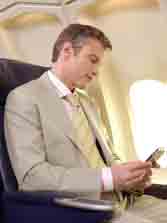Boeing's decision to shut down its loss-making Connexion division has not discouraged rival in-flight connectivity providers from pushing ahead with plans to offer what they insist will be more affordable passenger communication services.
Underlining this, Australian carrier Qantas has agreed to a three-month evaluation of AeroMobile's service from early 2007 on board Boeing 767s operating domestic routes. And Irish budget carrier Ryanair is to equip its entire Boeing 737 fleet with OnAir's on-board mobile phone system.
But the setback suffered by the world's largest aerospace company, which will result in it taking a pre-tax charge of up to $320 million, has sounded yet another warning to an industry accustomed to seeing in-flight entertainment (IFE) services fall short of expectations.
|
|
|---|
| Bring your own - the next step? |
Initially, AeroMobile is using Inmarsat's "classic" narrowband satellite communications as a "stepping stone" to support its in-flight voice and short messaging service using passengers' own GSM mobile phones. This ensures AeroMobile is "cost effective and very light", says Tuggey, but it also provides "an economic vision" that gives airlines "tangible levels of connectivity on the satcom systems they have today, yet the same architecture will also support broadband" in the future.
The company is on target to begin revenue service this year, with two airlines to launch its voice and messaging services in the next six months, says Tuggey.
OnAir, a joint venture between Airbus, Sita and Tenzing that will use Inmarsat's SwiftBroadband satcom, has also taken a different approach to Connexion "from the very basics of the technology used, to the most fundamental element: the needs and preferences of the target market", says chief executive George Cooper.
The company's model "recognises passengers' differing requirements, ranging from using their mobile or BlackBerry-type devices, to accessing webchat and webmail through the in-seat in-flight entertainment system, to full Wi-Fi internet and VPN access through their laptops", Cooper says.
Air France will carry out a six-month single-aircraft trial of OnAir's GSM phone connectivity service next year - the third carrier after BMI and TAP Portugal to sign up for a trial and the first to take an aircraft line-fitted with the system.
Connexion by Boeing's approach was to provide high-speed connectivity to a passenger's laptop, via leased Ku-band satellites. Lack of demand was the reason cited for halting Connexion sales in June and the company's subsequent announcement it will shut down the business unit and work with customers "to facilitate an orderly phase out" of the service. But the cost of making aircraft compatible with the service was a major deterrent to many potential customers.
US Airways vice-president of sales, marketing and distribution Travis Christ, has said that, after considering weight and wiring issues, Connexion proved "more than we could afford".
Those Asian and European operators that did adopt Connexion have expressed disappointment at Boeing's decision. Lufthansa says it hopes a solution can be found to continue the service. But South Korean carrier Asiana, which has service on two of its 777s, says it is in negotiations with Boeing and may receive compensation. Boeing declines to comment on reports that Korean Air, which has Connexion on 29 747-400s and 777s, intends to ask the company to reimburse at least $12 million.
Boeing expects to record a pre-tax charge of up to $320 million, of which about $290 million is expected to be recognised in the third quarter and $30 million in the fourth quarter. This includes write-downs of assets of $472 million, contract termination costs of $168 million (including operating leases, supplier and customer costs), offset by a gain of $320 million associated primarily with early termination of capital lease obligations.
The shutting down of Connexion, therefore, will be one of the more expensive missteps in an in-flight communications market that seen its share of reversals. But the lure of connecting passengers wherever they fly is still bringing companies into the market. In the USA, AirCell is developing air-to-ground wireless services that the company says "will be a fraction of the cost of satellite-based broadband systems".
The Colorado-based company in June won an exclusive broadband licence at a US government auction. Targeted for launch in 2007, AirCell's ground-based network will initially cover the continental USA, but is expandable to Canada, Mexico and the Caribbean.
Like AeroMobile and OnAir, AirCell's system will support the use of cellular telephones on board aircraft. But further regulatory approvals are required before this can be offered in the USA. And the social issues surrounding passenger cellphone use have yet to be resolved. The business case for in-flight connectivity, it seems, has still to be proved
Source: Flight International

















